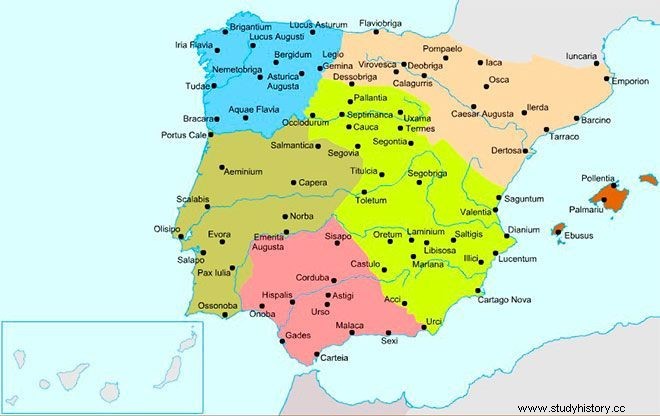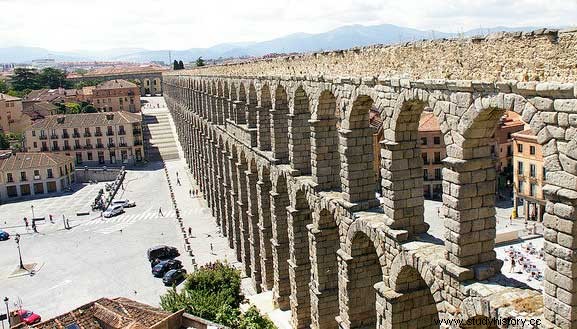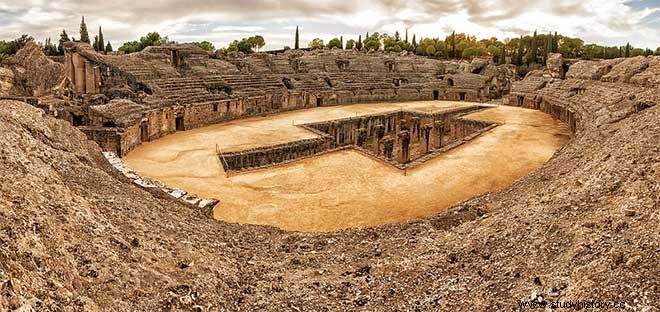A decisive step in the Hispanic historical evolution was the occupation of the peninsular lands by the Roman armies. The starting point was the struggle sustained by the then Roman republic with Carthage, which it had occupied, in the middle of the third century before Christ , the Iberian Peninsula. Rome managed to conquer the main bases of the Carthaginians on Hispanic soil, Carthago Nova and Gades. However, as a result of that success, the Romans, who initially had settled only in the coastal areas of the east and south of the Iberian Peninsula, decided to incorporate all of the Iberian lands into their domains.
The process concluded in the first century before Christ, not without encountering strong resistance on occasions, such as that of the Lusitanian leader Viriato, assassinated in the year 139 before Christ; that of the Celtiberian city of Numancia, surrendered to Rome in 133 BC, or, ultimately, that of the Cantabrians and Asturians, whom Augustus himself ended up defeating in 19 BC. The reasons that prompted the Romans to be interested in the Iberian Peninsula were both economic and strategic. Hispania supplied Rome above all with metals , but also provided soldiers and labor. On the other hand, the Romans were the ones who decided to use the name of Hispania to refer to the Iberian lot, a term from which the later Romance words España, in Castilian, or Espanya, in Catalan, would derive.

Hispania became part of the powerful Empire that had its vital center in the city of Rome. Roman Hispania initially had two provinces, Citerior and Ulterior . Later it was divided into a mosaic of provinces, such as Tarraconense, Gallaecia, Cartaginense, Lusitania, Bética and Mauritania Tingitana, the latter referring to North Africa, and the latter to Balearic. The Romans took full advantage of the economic possibilities of Hispania, in particular its mining operations, which were owned by the State. In the Carthago Nova mining district, where mainly silver, but also lead, was mined, it is estimated that some 40,000 men worked, earning an estimated profit of about 25,000 drachmas a day. Another outstanding activity was fishing, in particular the salted fish from the Atlantic coast of Andalusia. Also important was the development of slavery, which reached very high levels. Society, for its part, was divided into two clearly opposed groups:on the one hand, the honestiores , that is, the dominant ones; on the other, the humiliores , the popular layer. In any case, there was a clear difference between those who had Roman citizenship and those who did not. This situation lasted until the year 212, the date on which Emperor Caracalla decided to grant Roman citizenship to all his subjects.
The use of the Latin language was generalized, which ended up cornering most of the languages that were spoken in Hispanic lands. The only language that survived from the past was Basque , which was spoken in the lands of the current territories of the Basque Country and Navarra. Spectacular progress was experienced in Hispanic lands, especially urban life, with nuclei such as Caesaraugusta, Barcino, Tarraco, Toletum, Lucus, Asturica Augusta, Saguntum, Valentía, Carthago Nova, Norba, Emérita Augusta, Corduba, Hispalis, Carteia, Malaca, cades etc. The Hispano-Roman cities were the scene of the development of the institution of the municipality, which was made up of a Curia or Council and some magistrates, among them, as the most prominent, the duoviri and the aediles . At the same time, a dense network of communication routes, the starting point of the main routes of subsequent centuries, ran through the Iberian site. A very significant one, the famous Via de la Plata .
At the same time Roman law penetrated, whose traces are still clearly perceptible in the current legal regulations in Spain today. The traces of the Hispano-Roman past are still visible from the walls of Lugo or the aqueduct of Segovia to the theater of Mérida, the amphitheater of Itálica or the arches of Bará and Medinaceli. Hispania, likewise, contributed a very outstanding list of great figures to the history of Rome, from emperors, such as Trajan, to writers, including Seneca, Lucan, Quintilian or Martial, passing through the agronomist Columela or the geographer Mela.

ExpansionoftheChristianreligion
The time of Roman domination was also witness to the arrival of the Christian religion in the Iberian Peninsula, which was to become one of the strongest pillars of the future of Hispanic lands. At first, the spread of Christianity was slow, because it was a persecuted religion. The Christian Church was already strongly implanted in Hispanic lands in the third century. The Edict of Milan, issued by Emperor Constantine in the year 313, allowed Christianity to rise to the surface. At the beginning of the fourth century, of the Council that took place in the Granada town of Iliberis, attended by 37 bishops. Before the end of that century, Emperor Theodosius proclaimed Christianity the official religion of the Roman Empire. Hispanic Christianity during the imperial era contributed distinguished names, some martyrs, such as Justo y Pastor or Eulalia de Mérida, but also outstanding figures, such as Bishop Osio, the historian Orosio and the poet Prudencio. But there were also doctrinal deviations, the most significant of which was that of Prisciliano, who was bishop of Ávila in the fourth century. Priscillianism, which was accused of being related to magic and Manichaeism, nevertheless survived its founder, reaching a notable expansion, above all through the Roman provinces of Gallaecia and Lusitania.

